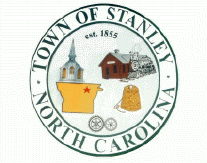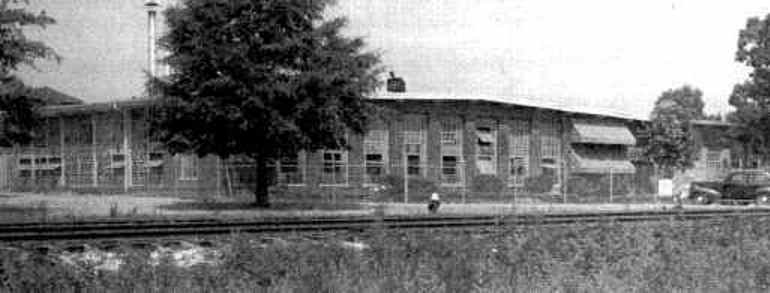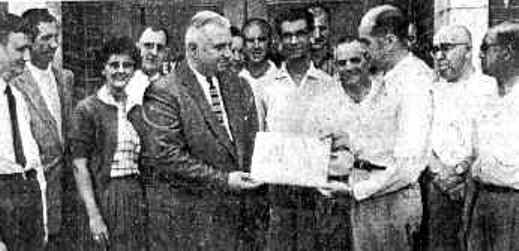


















|
The History of Stanley, North
Carolina
[ Back ] [ Next ]
The Community
Industry, Interests, Town Government
  
Industries
Stanley and the Industrial Revolution
 |
|
The Official Seal of the Town of Stanley |
During the sixty-four years of the Victorian era, from 1837 to 1901, great changes were made in almost
every aspect of life of the people of North Carolina. Railroads were built during this period linking
villages and cities and enabling farmers to ship their crops and wares more easily and economically.
Factories had been built all over the state, such as the one in Brevard's Station which began on 17
April 1891. This was the Stanley Creek Cotton Mills. This indenture was begun with an initial investment
of $20,000. It became the Stanley Manufacturing Company in 1894 and on 16 March 1910 was under the
proprietorship of A. P. Rhyne, H. A. Rhyne and William H. Summers for an investment of $100,000.
On 11 April 1918 the Stanley Manufacturing Company cotton mill became the Lola Manufacturing Company,
under the proprietorship of John C. Rankin, S. M. Robinson and Robert Fulton Craig. At the time of
purchase this mill began with 2,500 spindles and enlarged to 10,000 spindles.
An addition to this mill became the Lola Gingham Mill which operated for the
purpose of weaving gingham fabrics.
In addition to the Lola Manufacturing Company, in 1930 and the fledgling
Gaston County Dyeing Machine Company, other industries in Stanley were:
Sherrill & Taylor Ginnery, a cotton gin;
Lowe Manufacturing Company, engaged in making bedspreads;
Center Garage, making general automotive repairs;
Sinclair Filling Station, for gas and automotive repairs;
Standard Filling Station, gas and selling Standard products;
A Furniture Manufacturer, making outdoor furniture and rocking chairs;
Gulf Service Station, gas and Gulf products;
Several Sawmills, some on private property (one was the Hawley Saw Mill);
and 6 Dairies within the town and surrounding area, including the Stanley Creamery which was
located off of Plum Street.
On 28 April 1930 a silk mill was begun in Stanley. They had purchased the
Lola Gingham Mill which had been idle for several years. The principals in this
business were George H. Hacker, Fred A. Katterman, August Katterman, Fred
Mitchell. This was named the Katterman and Mitchell Mill. This silk mill was
originated in Patterson, New Jersey and was begun with a capital of $3,000,000.
Lola Mills, Inc., began on 3 June 1932, with captial of $68,000 and headed by
R. N. Aycock, John M. Scott, E. R. Bucher. J. A. Bangle was president and Inzie
Eugene Craig, son of Robert F. Craig, was Vice President; Robert F. Craig was
treasurer and general manager, and another son, Hubert M. Craig was secretary
and assistant treasurer.
 |
| Katterman and Mitchell Mill |
The Strike
Life was a struggle during the Depression years. Many people left their farms
or ventured down to the Piedmont from the mountains to go to work in the mill in
an attempt to better their life. In actuality they were working extremely hard,
long hours and for very little pay. Children, some as young as 10 years of age,
were working along with their parents in the mills.
Most of the textile workers and their families lived on the mill village in
houses owned by the owners of the mill. There was much comradery among the
families who lived on the mill village. The world of the Cotton Mill Village was
like that of a family. Many lasting friendships were made and many memories are
held of life in the early years of the mill village.
During the Great Depression Years, the 1920's and the early 1930's, the Textile Worker's Union
attempted to organize textile employees throughout the Southeast. It was during those years that the
Katterman & Mitchell Silk Mill was located at Stanley.
Franklin Delano Roosevelt was elected President in 1932 and with his New Deal people began to
feel that the Depression would soon be over. Included in the New Deal were the Textile Codes
which required a minimum wage of $12.00 a week as well as stipulating that employees should have the
right to meet, discuss their working conditions, pay, etc., without interference from their employers.
However, the mill owners, Katterman & Mitchell in Stanley included, refused to acknowledge the
New Deal Textile Codes. This led to more determined attempts by the workers to organize and join
the Textile Workers Union. The result of this being that the largest single labor conflict in
American History, a strike of 400,000 textile workers, happened and much of it was in Gaston County,
Stanley included.
In order to speed along the process of the strike, the Union organized groups of members to go to the
individual mills simultaneously attempting to close down all the mills. These groups were called the
Flying Squadrons. Bill Smith remembers that some men from Stanley were among the Flying
Squadrons and they succeeded in closing down the Mariposa Mill.
The Federal Government sent out the Home Guard or Militia (National Guard). At first it was
thought they were sent out to insure the safety of the strikers because the New Deal Textile Codes
were not being acknowledged by proprietors of the mills. But in actuality they began arresting all
the Flying Squadrons. A lot of the Home Guardsmen were workers in the mill or had
family working in the mill or were sons of mill owners, and their sympathies lay on the side of the
textile leaders. A striker in Belmont, NC was killed and seven other strikers were killed in Honea
Path, SC. After hearing that Squadrons in Lincolnton had been arrested the Stanley members feared
they too would be sent to jail so they disbanded.
Over the years since 1934 very little had been said about the strike and few people are aware that
our foreparents, through acts of much courage, ever willingly defied the leadership of this historic
industry.
Unfortunate as it was the Textile Codes seemed to have no substance and therefore the workers were
left with no backing from the government. President Roosevelt intervened in the strike, requesting
that all workers return to their jobs in the mills. From that point on there was blacklisting,
firing and some people were evicted from their mill village homes. The textile leaders still refused
to negotiate but yet continued to expect worker loyalty. This had occurred all over the South as well
as in Stanley. Textile workers in Stanley never again joined a union.
After The Depression
Gaston County Dyeing Machine Company
had survived the depression. It was during those times
that Robert Craig's son, Hubert M. Craig, became an officer in the company.
With the advent of synthetics, production at the Kattermann and Mitchell Silk Mill began to wane
until it finally stopped production in 1939.
George Hacker, a German immigrant, who
came to Stanley with Kattermann and Mitchell Mills, began working, in 1936, with Gaston County Dyeing
Machine Company. He served as vice president and general manager of the company until his death in
1963.
The old Kattermann and Mitchell Mill was
bought by an investment group headed by 0. Max
Gardner of Shelby, N. C. in 1941 and became known as the Stanley Mills. Renovations were made and a
new part was built to the mill. Production of rayon yarn began with an increase of 10,800 spindles.
In 1946 the Stanley Mills became a subsidiary of J. P. Stevens & Company out of New York, NY.
During 1946-1947 a Worsted Department was added to the mill.
In 1947 the old Lola Mills property was acquired and became a part of J. P. Stevens & Co. On
29 April 1950 Stanley Mills was dissolved and became a division of J. P. Stevens, combining all
the mills into one. An addition of 29,158 square feet was added in
1962. In 1963 approximately 860 persons were employed.
There was a leverage buyout in May of 1988
and the mill was no longer owned by J.P. Stevens &
Co., but became known as JPS Converter Yarns.
 |
Talon Zipper Plant Begins Operations in Stanley
Stanley Mayor, R. G. "Slick" Rhyne
(right) and town officials welcome Talon and Plant Manager James Hendley to Stanley |
Talon Zipper Plant Built in Stanley
Talon, Inc., the world's largest manufacturer
of zippers, a company that was organized in 1893,
announced plans in February of 1953 that they were
building a one million dollar factory in Stanley. They
would employ 200 people, giving the town a new
payroll of about $500,000.00 a year. Mr. McKee, a
representative from Talon's headquarters in
Meadville, PA, said that "we were looking for a town
that was not too large and not too great an industrial
center. We were also seeking local cooperation and a
good labor situation, and we believe we have found
both in Stanley."
Hubert Craig, President of Gaston County
Dyeing Machine Co., made the initial contact with the
Talon people enticing them to locate in Stanley by
quoting figures from Census records which indicate
that Stanley has grown and is progressing faster than
any other town in Gaston County. The Census figures
showed that population had increased in Stanley 60
percent in the last 10 years to 2000 citizens.
The new plant, a one story building containing
about 62,000 square feet, was situated on 14 acres of
land which was once known as "the Bill Murphy" land
on Hovis Road. Construction of the plant was
completed in late 1953.
James A. Hendley was secured as the new
Plant Manager for Stanley's Talon plant. Other men in
management positions in Meadville, PA, were also
transferred to Stanley and the rest of the employees
were local citizens. Fred Phil was transferred here to
head up the dye department which dyed tape for all the
zippers in the company. Mr. Hendley and Mr. Phil
continued with the company here in Stanley until their
retirement.
A few years later an addition was built which
enlarged the plant to almost double the original size.
Several more people in managerial positions were
transferred to Stanley, some of them, Jim Williams,
Stan Koehler and August Schwab, stayed with the
company and called Stanley their home.
The company went through several
mergers and has since closed and moved all operations to Mexico.
|
  
[ The Museum ] [ Contact Us ] [ Stanley History ] [ Photo Galleries ] [ Citizens ] [ Recollections ] [ Schools ] [ Churches ] [ Community ] [ Recent History ] [ Order the Books ] [ Topic Index ] [ Site Index ] [ Search ] [ Acknowledgments ] [ Related Links ] [ Guestbook ]
|
|





